Information Theory and Statistical Learning
�
Frank Emmert-Streib Matthias Dehmer
Information Theory
and Statistical Learning
ABC
�
Frank Emmert-Streib
University of Washington
Department of Biostatistics
and Department of Genome Sciences
1705 NE Pacific St.,
Box 357730
Seattle WA 98195, USA
and
Queen’s University Belfast
Computational Biology
and Machine Learning
Center for Cancer Research
and Cell Biology
School of Biomedical Sciences
97 Lisburn Road, Belfast BT9 7BL, UK
v@bio-complexity.com
Matthias Dehmer
Vienna University of Technology
Institute of Discrete Mathematics
and Geometry
Wiedner Hauptstr. 8–10
1040 Vienna, Austria
and
University of Coimbra
Center for Mathematics
Probability and Statistics
Apartado 3008, 3001–454
Coimbra, Portugal
matthias@dehmer.org
ISBN: 978-0-387-84815-0
DOI: 10.1007/978-0-387-84816-7
e-ISBN: 978-0-387-84816-7
Library of Congress Control Number: 2008932107
c Springer Science+Business Media, LLC 2009
All rights reserved. This work may not be translated or copied in whole or in part without the written
permission of the publisher (Springer Science+Business Media, LLC, 233 Spring Street, New York,
NY 10013, USA), except for brief excerpts in connection with reviews or scholarly analysis. Use in
connection with any form of information storage and retrieval, electronic adaptation, computer software,
or by similar or dissimilar methodology now known or hereafter developed is forbidden.
The use in this publication of trade names, trademarks, service marks, and similar terms, even if they are
not identified as such, is not to be taken as an expression of opinion as to whether or not they are subject
to proprietary rights.
Printed on acid-free paper
springer.com
�
Preface
This book presents theoretical and practical results of information theoretic methods
used in the context of statistical learning. Its major goal is to advocate and promote
the importance and usefulness of information theoretic concepts for understanding
and developing the sophisticated machine learning methods necessary not only to
cope with the challenges of modern data analysis but also to gain further insights
into their theoretical foundations. Here Statistical Learning is loosely defined as a
synonym, for, e.g., Applied Statistics, Artificial Intelligence or Machine Learning.
Over the last decades, many approaches and algorithms have been suggested in the
fields mentioned above, for which information theoretic concepts constitute core
ingredients. For this reason we present a selected collection of some of the finest
concepts and applications thereof from the perspective of information theory as the
underlying guiding principles. We consider such a perspective as very insightful and
expect an even greater appreciation for this perspective over the next years.
The book is intended for interdisciplinary use, ranging from Applied Statistics,
Artificial Intelligence, Applied Discrete Mathematics, Computer Science, Infor-
mation Theory, Machine Learning to Physics. In addition, people working in the
hybrid fields of Bioinformatics, Biostatistics, Computational Biology, Computa-
tional Linguistics, Medical Bioinformatics, Neuroinformatics or Web Mining might
profit tremendously from the presented results because these data-driven areas are
in permanent need of new approaches to cope with the increasing flood of high-
dimensional, noisy data that possess seemingly never ending challenges for their
analysis.
Many colleagues, whether consciously or unconsciously, have provided us with
input, help and support before and during the writing of this book. In particular we
would like to thank Shun-ichi Amari, Hamid Arabnia, G¨okhan Bakır, Alexandru T.
Balaban, Teodor Silviu Balaban, Frank J. Balbach, Jo˜ao Barros, Igor Bass, Matthias
Beck, Danail Bonchev, Stefan Borgert, Mieczyslaw Borowiecki, Rudi L. Cilibrasi,
Mike Coleman, Malcolm Cook, Pham Dinh-Tuan, Michael Drmota, Shinto Eguchi,
B. Roy Frieden, Bernhard Gittenberger, Galina Glazko, Martin Grabner, Earl
Glynn, Peter Grassberger, Peter Hamilton, Kateˇrina Hlav´aˇckov´a-Schindler, Lucas
R. Hope, Jinjie Huang, Robert Jenssen, Attila Kert´esz-Farkas, Andr´as Kocsor,
v
�
vi
Preface
Elena Konstantinova, Kevin B. Korb, Alexander Kraskov, Tyll Kr¨uger, Ming Li, J.F.
McCann, Alexander Mehler, Marco M¨oller, Abbe Mowshowitz, Max M¨uhlh¨auser,
Markus M¨uller, Noboru Murata, Arcady Mushegian, Erik P. Nyberg, Paulo Eduardo
Oliveira, Hyeyoung Park, Judea Pearl, Daniel Polani, S´andor Pongor, William
Reeves, Jorma Rissanen, Panxiang Rong, Reuven Rubinstein, Rainer Siegmund
Schulze, Heinz Georg Schuster, Helmut Schwegler, Chris Seidel, Fred Sobik, Ray
J. Solomonoff, Doru Stefanescu, Thomas Stoll, John Storey, Milan Studeny, Ulrich
Tamm, Naftali Tishby, Paul M.B. Vit´anyi, Jos´e Miguel Urbano, Kazuho Watanabe,
Dongxiao Zhu, Vadim Zverovich and apologize to all those who have been missed
inadvertently. We would like also to thank our editor Amy Brais from Springer who
has always been available and helpful. Last but not least we would like to thank our
families for support and encouragement during all the time of preparing the book
for publication.
We hope this book will help to spread the enthusiasm we have for this field and
inspire people to tackle their own practical or theoretical research problems.
Belfast and Coimbra
June 2008
Frank Emmert-Streib
Matthias Dehmer
�
Contents
1
Algorithmic Probability: Theory and Applications . . . . . . . . . . . . . . . .
Ray J. Solomonoff
1
2 Model Selection and Testing by the MDL Principle . . . . . . . . . . . . . . . 25
Jorma Rissanen
3
4
Normalized Information Distance . . . . . . . . . . . . . . . . . . . . . . . . . . . . . . 45
Paul M. B. Vit´anyi, Frank J. Balbach, Rudi L. Cilibrasi, and Ming Li
The Application of Data Compression-Based Distances
to Biological Sequences . . . . . . . . . . . . . . . . . . . . . . . . . . . . . . . . . . . . . . . 83
Attila Kert´esz-Farkas, Andr´as Kocsor, and S´andor Pongor
5 MIC: Mutual Information Based Hierarchical Clustering . . . . . . . . . . 101
Alexander Kraskov and Peter Grassberger
6
7
8
9
A Hybrid Genetic Algorithm for Feature Selection
Based on Mutual Information . . . . . . . . . . . . . . . . . . . . . . . . . . . . . . . . . 125
Jinjie Huang and Panxiang Rong
Information Approach to Blind Source Separation
and Deconvolution . . . . . . . . . . . . . . . . . . . . . . . . . . . . . . . . . . . . . . . . . . . 153
Pham Dinh-Tuan
Causality in Time Series: Its Detection and Quantification by Means
of Information Theory . . . . . . . . . . . . . . . . . . . . . . . . . . . . . . . . . . . . . . . 183
Kateˇrina Hlav´aˇckov´a-Schindler
Information Theoretic Learning and Kernel Methods . . . . . . . . . . . . . 209
Robert Jenssen
10
Information-Theoretic Causal Power . . . . . . . . . . . . . . . . . . . . . . . . . . . 231
Kevin B. Korb, Lucas R. Hope, and Erik P. Nyberg
vii
�
viii
11
Information Flows in Complex Networks . . . . . . . . . . . . . . . . . . . . . . . . 267
Jo˜ao Barros
Contents
12 Models of Information Processing in the Sensorimotor Loop . . . . . . . 289
Daniel Polani and Marco M¨oller
13
Information Divergence Geometry and the Application to Statistical
Machine Learning . . . . . . . . . . . . . . . . . . . . . . . . . . . . . . . . . . . . . . . . . . . 309
Shinto Eguchi
14 Model Selection and Information Criterion . . . . . . . . . . . . . . . . . . . . . . 333
Noboru Murata and Hyeyoung Park
15 Extreme Physical Information as a Principle of Universal Stability . . 355
B. Roy Frieden
16 Entropy and Cloning Methods for Combinatorial Optimization,
Sampling and Counting Using the Gibbs Sampler . . . . . . . . . . . . . . . . 385
Reuven Rubinstein
Index . . . . . . . . . . . . . . . . . . . . . . . . . . . . . . . . . . . . . . . . . . . . . . . . . . . . . . . . . . . . . 435
�
Contributors
Institute of Statistical Mathematics, 4-6-7 Minami-Azabu,
Instituto de Telecomunicac¸ ˜oes, Universidade do Porto, Porto,
Frank J. Balbach, University of Waterloo, Waterloo, ON, Canada,
fbalbach@uwaterloo.ca
Jo˜ao Barros,
Portugal, barros@dcc.fc.up.pt
Rudi L. Cilibrasi, CWI, Kruislaan 413, 1098 SJ Amsterdam, The Netherlands,
cilibrar@cilibrar.com
Pham Dinh-Tuan, Laboratory Jean Kuntzmann, CNRS-INPG-UJF BP 53, 38041
Grenoble Cedex, France, Dinh-Tuan.Pham@imag.fr
Shinto Eguchi,
Minato-ku, Tokyo 106-8569, Japan, eguchi@ism.ac.jp
B. Roy Frieden, College of Optical Sciences, University of Arizona, Tucson, AZ
85721, USA, roy.frieden@optics.Arizona.edu
Peter Grassberger, Department of Physics and Astronomy and Institute for
Biocomplexity and Informatics, University of Calgary, 2500 University Drive NW,
Calgary AB, Canada T2N 1N4, pgrassbe@ucalgary.ca
Lucas R. Hope, Bayesian Intelligence Pty. Ltd., lhope@bayesian-intelligence.com
Kateˇrina Hlav´aˇckov´a-Schindler, Commission for Scientific Visualization,
Austrian Academy of Sciences and Donau-City Str. 1, 1220 Vienna, Austria and
Institute of Information Theory and Automation of the Academy of Sciences of the
Czech Republic, Pod Vod´arenskou vˇeˇz´ı 4, 18208 Praha 8, Czech Republic,
katerina.schindler@assoc.oeaw.ac.at
Jinjie Huang, Department of Automation, Harbin University of Science and
Technology, Xuefu Road 52 Harbin 150080, China, jinjiehyh@yahoo.com.cn
Robert Jenssen, Department of Physics and Technology, University of Tromsø,
9037 Tromso, Norway, robert.jenssen@phys.uit.no
ix
�
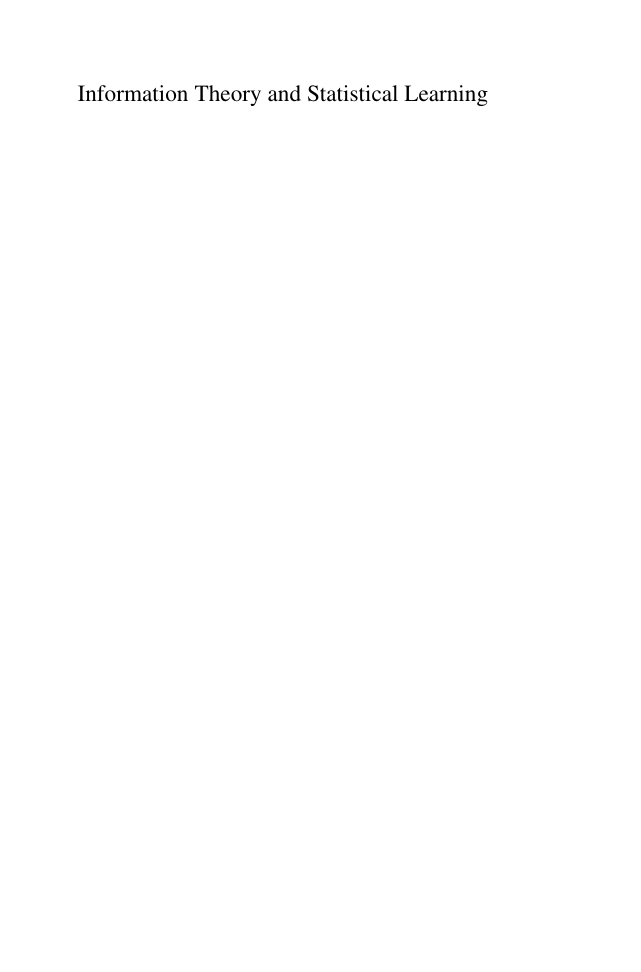
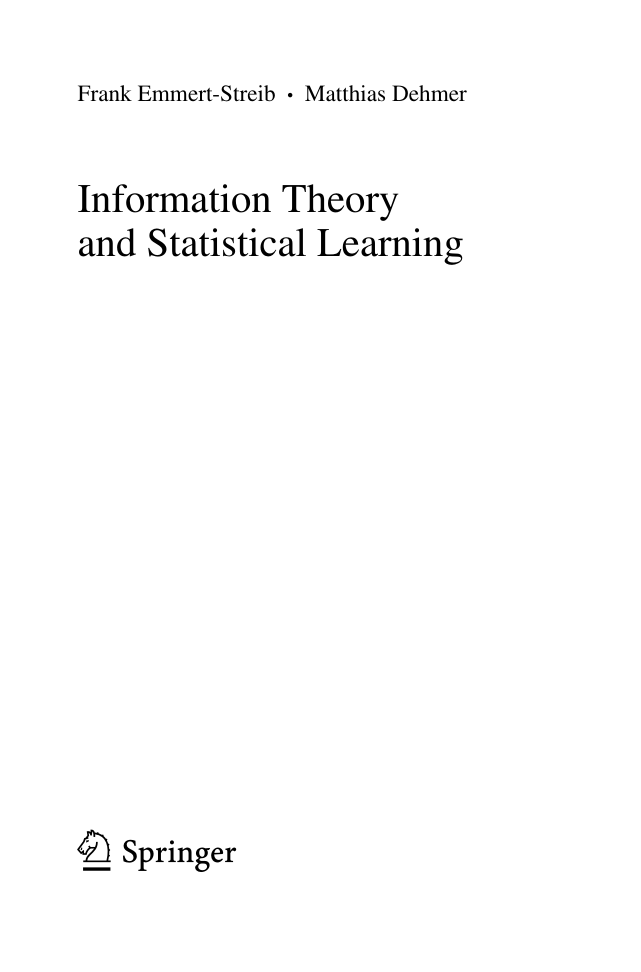
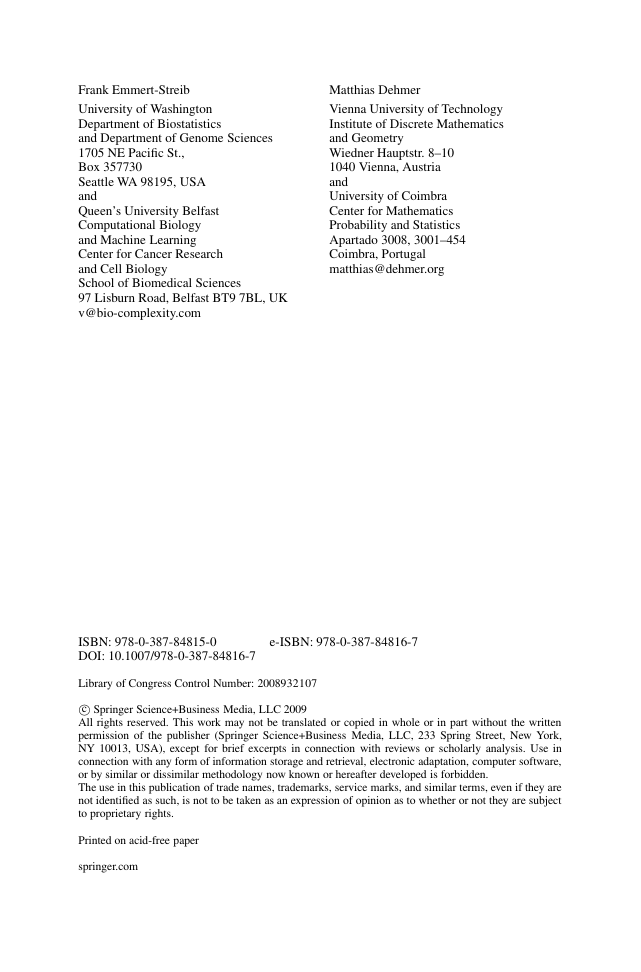
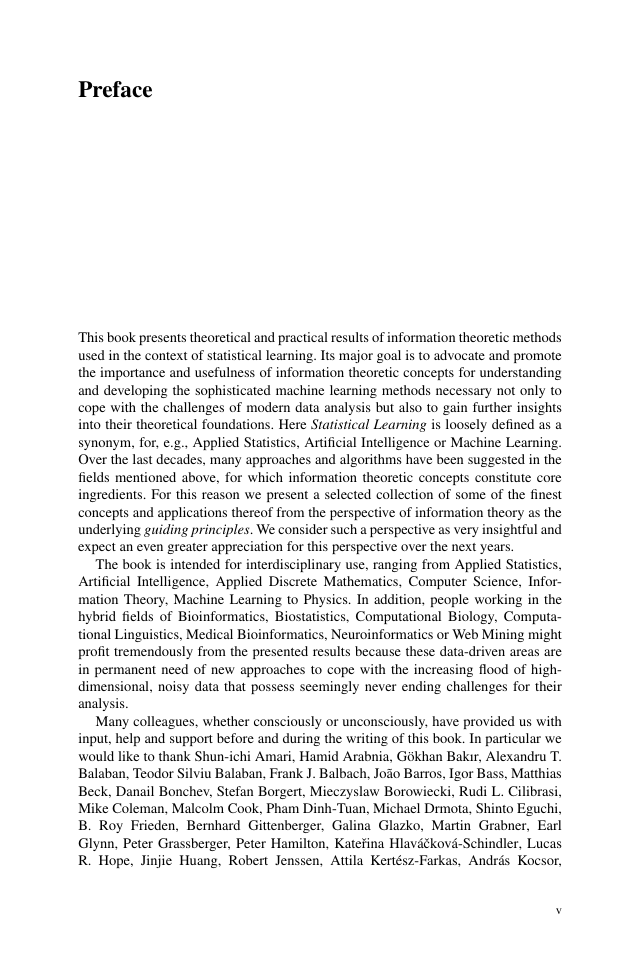
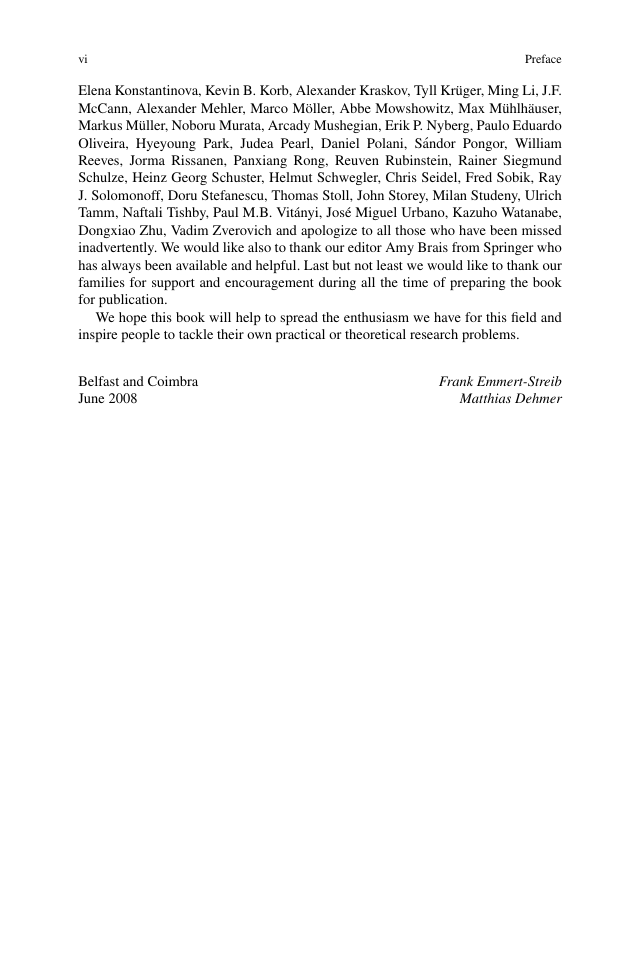
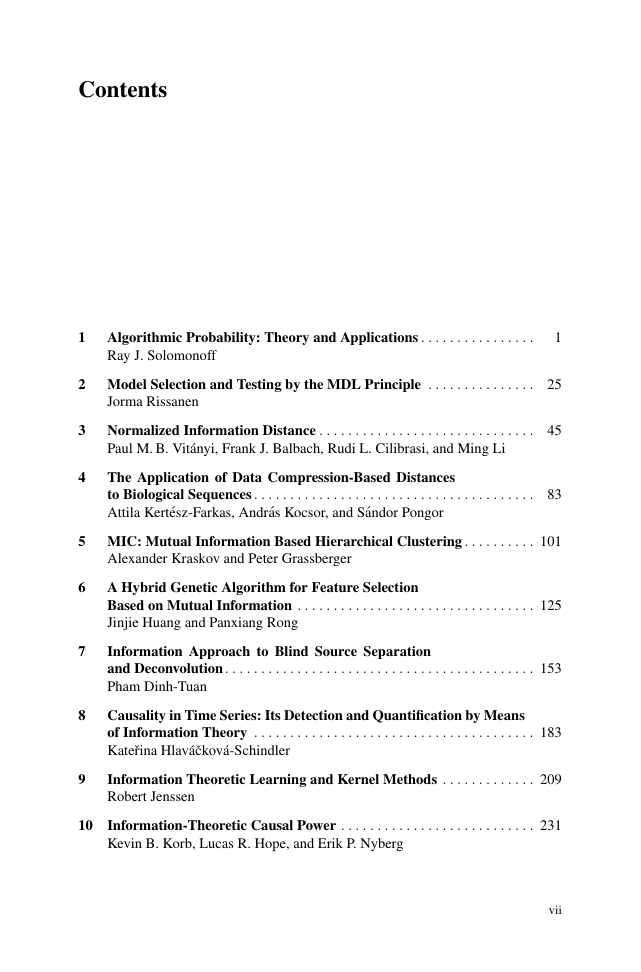










 2023年江西萍乡中考道德与法治真题及答案.doc
2023年江西萍乡中考道德与法治真题及答案.doc 2012年重庆南川中考生物真题及答案.doc
2012年重庆南川中考生物真题及答案.doc 2013年江西师范大学地理学综合及文艺理论基础考研真题.doc
2013年江西师范大学地理学综合及文艺理论基础考研真题.doc 2020年四川甘孜小升初语文真题及答案I卷.doc
2020年四川甘孜小升初语文真题及答案I卷.doc 2020年注册岩土工程师专业基础考试真题及答案.doc
2020年注册岩土工程师专业基础考试真题及答案.doc 2023-2024学年福建省厦门市九年级上学期数学月考试题及答案.doc
2023-2024学年福建省厦门市九年级上学期数学月考试题及答案.doc 2021-2022学年辽宁省沈阳市大东区九年级上学期语文期末试题及答案.doc
2021-2022学年辽宁省沈阳市大东区九年级上学期语文期末试题及答案.doc 2022-2023学年北京东城区初三第一学期物理期末试卷及答案.doc
2022-2023学年北京东城区初三第一学期物理期末试卷及答案.doc 2018上半年江西教师资格初中地理学科知识与教学能力真题及答案.doc
2018上半年江西教师资格初中地理学科知识与教学能力真题及答案.doc 2012年河北国家公务员申论考试真题及答案-省级.doc
2012年河北国家公务员申论考试真题及答案-省级.doc 2020-2021学年江苏省扬州市江都区邵樊片九年级上学期数学第一次质量检测试题及答案.doc
2020-2021学年江苏省扬州市江都区邵樊片九年级上学期数学第一次质量检测试题及答案.doc 2022下半年黑龙江教师资格证中学综合素质真题及答案.doc
2022下半年黑龙江教师资格证中学综合素质真题及答案.doc